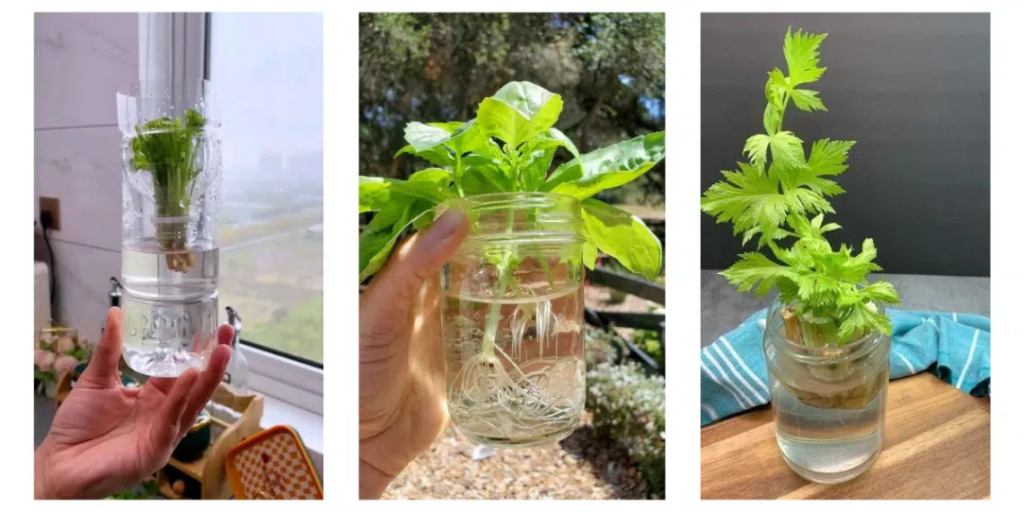
If you’re short on space but love the idea of having fresh herbs on hand, growing herbs in water is the perfect solution.
This easy, space-saving method allows you to enjoy vibrant, aromatic greens without the need for soil or large garden beds.
Whether you want to grow herbs in your kitchen window or add greenery to a small apartment, hydroponically growing herbs can give you a constant supply with minimal effort.
In this article, we’ll walk you through the process of growing herbs in water, the best herbs to try, and how to care for your water-grown plants for continuous harvests.
Why Grow Herbs in Water?
Growing herbs in water, also known as hydroponic herb gardening, offers several benefits:
- Space-saving: No need for pots or large garden beds.
- Low maintenance: No messy soil or complicated care routines.
- Year-round access: Grow fresh herbs indoors, even in winter.
- Cost-effective: Propagate herbs from cuttings instead of buying new plants.
- Great for beginners: It’s easy, fun, and perfect for novice gardeners.
Best Herbs to Grow in Water
Not all herbs grow well in water, but the following varieties are excellent candidates:
- Basil
Basil thrives in water and grows quickly, making it one of the best herbs to start with. Plus, it’s perfect for salads, pesto, and pizza toppings. - Mint
Mint is another fast-growing herb that loves water. It’s ideal for refreshing teas, desserts, and cocktails. - Oregano
Oregano does well in water and offers flavorful leaves for pasta dishes, soups, and sauces. - Rosemary
Though it grows a bit slower in water, rosemary provides a fragrant aroma and flavorful leaves for roasting and baking. - Thyme
Thyme adapts well to water and produces small, aromatic leaves that complement everything from meats to soups. - Sage
Sage is another herb that can grow in water, adding depth to savory dishes like stuffing, roasts, and sauces. - Lemon Balm
Lemon balm loves water and produces fresh, citrusy leaves for teas and desserts.
How to Grow Herbs in Water: Step-by-Step Guide
- Select Your Herbs:
Start with healthy cuttings from the herbs you want to grow. Choose stems that are 4-6 inches long with several leaves attached. - Prepare the Cuttings:
Remove the lower leaves from the stems, leaving only a few leaves at the top. This prevents the leaves from rotting in the water. - Choose a Container:
Use a glass jar, vase, or recycled bottle to hold your herbs. Transparent containers allow you to monitor root growth, but dark containers can prevent algae buildup. - Fill with Water:
Use filtered or distilled water to avoid chlorine or other chemicals that can harm the plants. Ensure the water covers the bottom of the cuttings but doesn’t submerge the leaves. - Change Water Regularly:
Replace the water every 3-5 days to prevent bacteria buildup and keep the herbs healthy. - Provide Light:
Place the containers in a bright, sunny spot, such as a windowsill, where the herbs receive at least 6 hours of indirect sunlight daily. If sunlight is limited, consider using a grow light. - Harvest and Enjoy:
Once the herbs develop roots and start growing, you can begin harvesting. Snip the leaves regularly to encourage new growth and keep the plants healthy.
Tips for Successful Herb Growth in Water
- Add liquid fertilizer: While herbs can survive in water alone, adding a diluted liquid fertilizer once a month boosts growth.
- Use rooting hormone: For herbs that are slow to root, dip the cut ends in rooting hormone to speed up the process.
- Watch for algae: If you notice algae growth in the container, switch to an opaque jar or change the water more frequently.
- Rotate the containers: Turn the containers occasionally to ensure the plants grow evenly and don’t lean toward the light.
Advantages of Growing Herbs in Water
- No soil mess: Perfect for indoor gardening without worrying about soil spills.
- Portable: Move your herbs around the house easily.
- Eco-friendly: Use recycled containers to create sustainable herb gardens.
- Immediate results: Start harvesting herbs just a few weeks after planting.
- Decorative appeal: Glass containers filled with green herbs can add a cozy touch to any space.
A Simple Way to Enjoy Fresh Greens All Year
Growing herbs in water is a simple, space-saving solution that ensures you always have fresh, fragrant greens at your fingertips.
With just a little care and the right environment, you can enjoy a variety of herbs without the hassle of soil or large garden spaces.
Whether you’re growing basil for pesto, mint for tea, or rosemary for roasts, hydroponic herb gardening brings convenience, beauty, and freshness into your home.
Try starting your own water-grown herb garden today, and experience the joy of harvesting homegrown herbs year-round—no matter the season!


